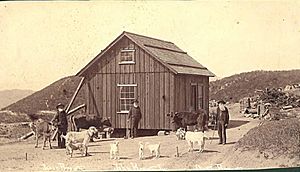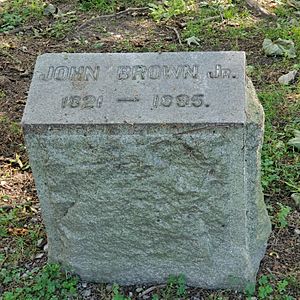John Brown Junior facts for kids
Quick facts for kids
John Brown Junior
|
|
|---|---|
 |
|
| Born | July 25, 1821 Hudson, Ohio, U.S.
|
| Died | May 5, 1895 (aged 73) Put-in-Bay, Ohio, U.S.
|
| Resting place | Crown Hill Cemetery, Put-in-Bay, Ohio |
| Known for | Anti-slavery activism |
| Children | 2 |
| Parent(s) | John Brown Dianthe Lusk Brown |
| Relatives | Owen Brown (grandfather) Owen Brown (brother) Watson Brown (half-brother) |
John Brown Jr. (born July 25, 1821 – died May 3, 1895) was the oldest son of the famous abolitionist John Brown. His mother was Brown's first wife, Dianthe Lusk Brown. Sadly, she passed away when John Jr. was only 11 years old. He was born in Hudson, Ohio.
In 1841, John Jr. tried working as a teacher in a country school. He found it very difficult and left after just one year. In the spring of 1842, he decided to study at the Grand River Institute in Austinburg, Ohio. In July 1847, he married Wealthy Hotchkiss. They made their home in Springfield, Massachusetts.
People who knew John Jr. described him as a smart and honest person. They said he was kind, warm-hearted, and well-liked by everyone. He was known for being active, energetic, and brave.
Contents
John Brown Jr. in Kansas
In the spring of 1855, John Jr. moved to Kansas Territory with four of his brothers. His brothers Frederick, Owen, and Salmon traveled by land. John Jr., his brother Jason, and their families traveled by boat on the Missouri River. John Jr. said the boat trip was "horrid" because the water was low. Most people on the boat supported slavery. The captain even left John Jr. and Jason's groups behind on purpose.
In 1856, John Jr. was chosen to be part of the territorial government. This was called the Topeka Legislature.
John Jr. did not take part in the Pottawatomie massacre in May 1856. However, he was captured by Henry Clay Pate. Pate was a "border ruffian" and led a group that supported slavery. John Jr. was handed over to federal soldiers. He was beaten and became very ill.
His father, John Brown, planned to rescue him. John Brown's group defeated the pro-slavery men in the Battle of Black Jack on June 2, 1856. John Brown captured Pate and his men. He agreed to let them go if his sons were released.
A court that supported slavery in Lecompton accused John Jr. of a serious crime. He was finally set free from prison in September. Soon after, John Jr. left Kansas with his father. His father took John Jr.'s heavy chains and showed them at meetings to fight against slavery.
Preparing for Harpers Ferry
John Jr. did not join his father's attack on Harpers Ferry. However, he knew all about the plans and helped prepare for the raid.
John Brown sent John Jr. on a trip through Pennsylvania. He wanted John Jr. to find brave men to join his group. John Jr. also visited Massachusetts, New York, and Canada. He tried to get support from Black people there. But these trips did not bring many new members. Only 21 men joined the attack on the Arsenal.
In the summer of 1859, John Jr. traveled around Ontario, Canada. He visited cities like Hamilton and Windsor. He was looking for support from Black Canadians for his father's plan. But he found very little help.
John Jr. was his father's main contact person for the raid in Virginia. In 1858, John Brown sent John Jr. to Virginia. His job was to explore the area around Harpers Ferry.
John Brown made John Jr. his "intelligence agent" and "liaison." This meant John Jr. was the go-between for John Brown and other people involved. This helped keep John Brown safe and the plans secret.
John Jr. received a secret message from his father. The message told him to move the "tools" for the raid. He was told to do this "with perfect quiet" and move only the tools to a safe place. John Jr. went to Conneaut, Ohio, where the weapons had been sent. He moved them to a farm in Cherry Valley Township, Ohio.
When his brother Owen escaped capture, he found safety with John Jr. at this home in Ohio.
In early 1860, the U.S. Senate started an investigation into the Harpers Ferry attack. They wanted John Jr. to come and speak to them. An officer was sent to arrest him in Ashtabula County, Ohio. But the officer reported that John Jr. could not be arrested without using armed force. Later, a group of twelve armed people tried to capture him but failed.
Civil War and Jennison's Jayhawkers
In the summer of 1860, John Jr. worked for the "Haytian Bureau of Emigration." He helped people move to Haiti. He also worked to help people move to British North America between 1860 and 1861.
In July 1861, John Jr. decided to gather a group of soldiers. They would go to Kansas and join the volunteer forces there. These forces were fighting in Missouri. John Jr. wanted to find strong abolitionists. His group was called John Brown's "Sharpshooters." They got a lot of attention as they traveled from Ohio to Kansas.
However, when they arrived, only 66 men had joined. In November 1861, John Jr.'s company decided to join Colonel Charles R. Jennison's First Kansas Cavalry. This group was known as Jennison's Jayhawkers. When John Jr. arrived in December, he became the captain of Company K. He served as captain until May 1862. He had to leave because of his rheumatoid arthritis, a painful joint condition. His second-in-command, George Henry Hoyt, took over as captain. Hoyt had been one of his father's lawyers after the Harpers Ferry attack.
Life After the War


After leaving the army in 1862, John Jr. bought 10 acres (4 hectares) of land. This land was on the south shore of South Bass Island at Put-in-Bay, Ohio. At that time, not many people lived there. He and his brother Owen were listed for Civil War Draft Registration in 1863.
John Jr. lived there until he passed away. He made a living by growing fruit. One newspaper said he grew "grapes for the Detroit market." It also said he never sold grapes for making wine, which his father would have liked. People who visited him described him as a "quiet, friendly, warm-hearted farmer." He was also interested in geology and surveying land. Later, he was described as "sunny" and "cheery-voiced."
His sister Ruth and her husband Henry Thompson also lived in Put-in-Bay for 19 years.
Later in his life, John Jr. became a socialist. He also traveled and gave talks about phrenology, which was a popular idea about reading character from head shapes.
By 1882, John Jr. was a respected leader in his community. That year, he traveled to Martinsville, Indiana. He went to identify the body of his brother Watson. He was even a guest for dinner with the Governor of Indiana.
In 1883, he wrote a long response to someone who criticized his father's actions in Kansas. This included the Pottawatomie massacre.
In 1887, he worked as a justice of the peace. He stayed in Put-in-Bay until his death on May 3, 1895. His life was described as "quiet, retired, but happy." Unlike his brother Owen, he enjoyed sharing the story of his father's life with close friends. He had a Masonic funeral, and thousands of people attended. It was the largest funeral ever held in Put-in-Bay. He is buried in Crown Hill Cemetery there.


